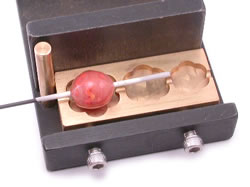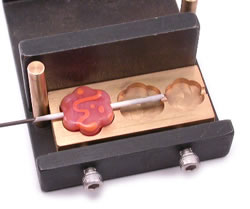|









Gift Certificates Available
| |
Daisy Tab Tutorial
|
|
|
Lay down your initial footprint and check the size by either bringing
the mandrel down to the base of the tool for reference, or the handle
portion of the tool up under your mandrel. You
will want your footprint to be about 1mm shy of the edges on both sides.
It is better to estimate smaller at first because you can always add
more to the footprint. Once it's on, you cannot take it off.
|
| |
|
 |
If you've followed our tip about determining
how
much glass you need for the cavity, you will know about how much
glass to wind onto your mandrel. The picture shows the suggested shape
before pressing. It is the shape of a plump oval.
Do not press when soupy and fully molten. Wait until your glass starts
to slightly 'form a skin' (don't wait too long or you won't be able
to press). Allow your glass to begin to settle into the bottom of the
tool so it doesn't slide around too much when you begin to press. |
| |
|
|
|
While centered over the cavity as shown above, press straight down
while steadying the tool against the back wall and left pole of the mold.
|
|
|
 |
If you want added sparkle, you might decide to leave
the chill marks, especially with transparent beads. If not, fire polish
away any chill marks on the surface! If you like crisper edges, be sure
to keep your flame on the faces of the bead, not the edges. |
| |
|
|
At this point you can also make your petals more defined
by using some type of tool to sharpen the crease. I like to use
the corner of my graphite marver but you can use any tool, such as a
Stump Shaper or razor tool. Just spot heat the area and touch lightly
with the tool. |
| |
|
|
Continue around to the different petal joints and there
you have it. |
|
|